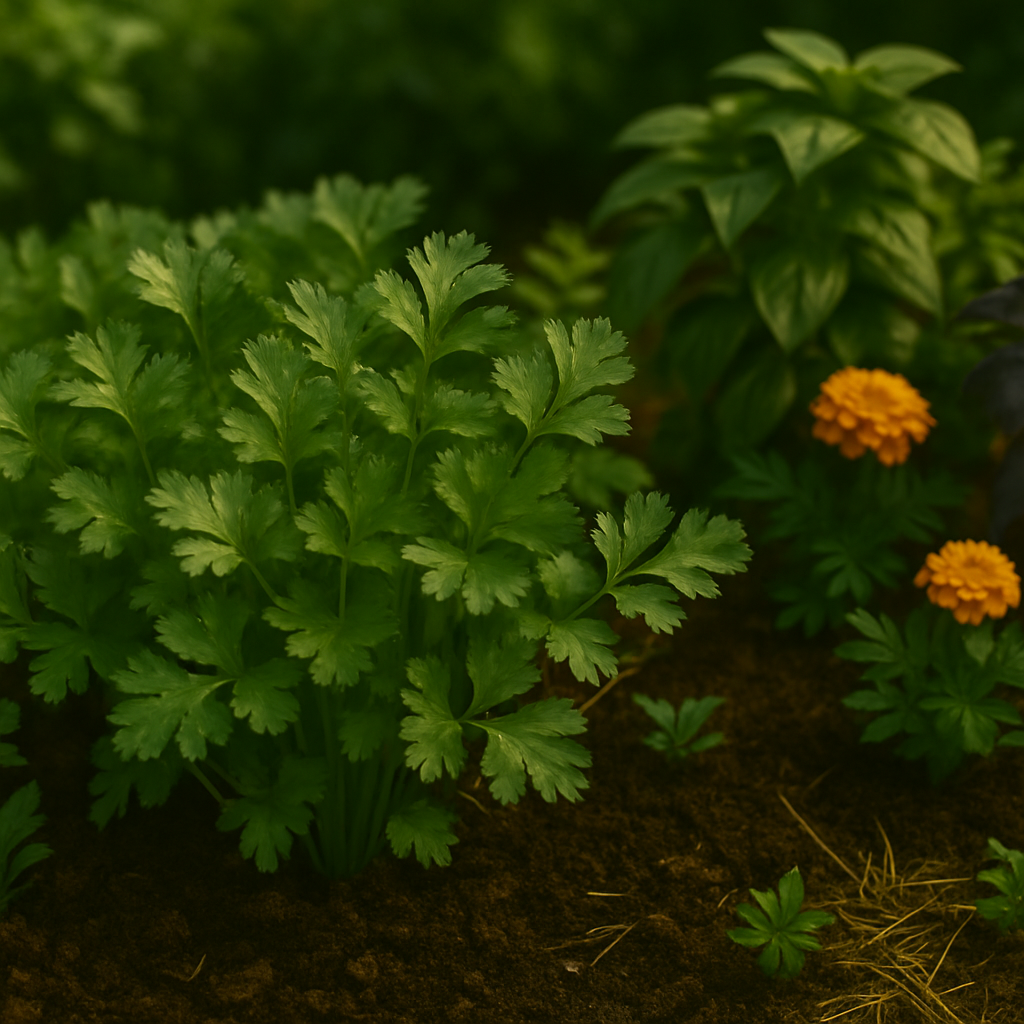Introduction
Cilantro pests can quickly turn a thriving herb garden into a source of frustration for any home cook or gardener. Whether you’re garnishing tacos, adding zest to curries, or blending fresh salsa, cilantro’s bold flavor makes it a favorite in kitchens and gardens around the world. However, its popularity isn’t limited to people—aphids, spider mites, and leafminers are just a few pests that love cilantro as much as we do, often appearing seemingly overnight.
Many gardeners struggle to find effective ways to protect their cilantro without using harsh chemicals, especially when those leaves are destined for the dinner table. The good news? There are plenty of safe, natural strategies to keep these cilantro pests at bay. In this post, we’ll explore the most common offenders and share actionable, chemical-free tips so you can enjoy lush, healthy cilantro all season long.
Common Pests That Affect Cilantro
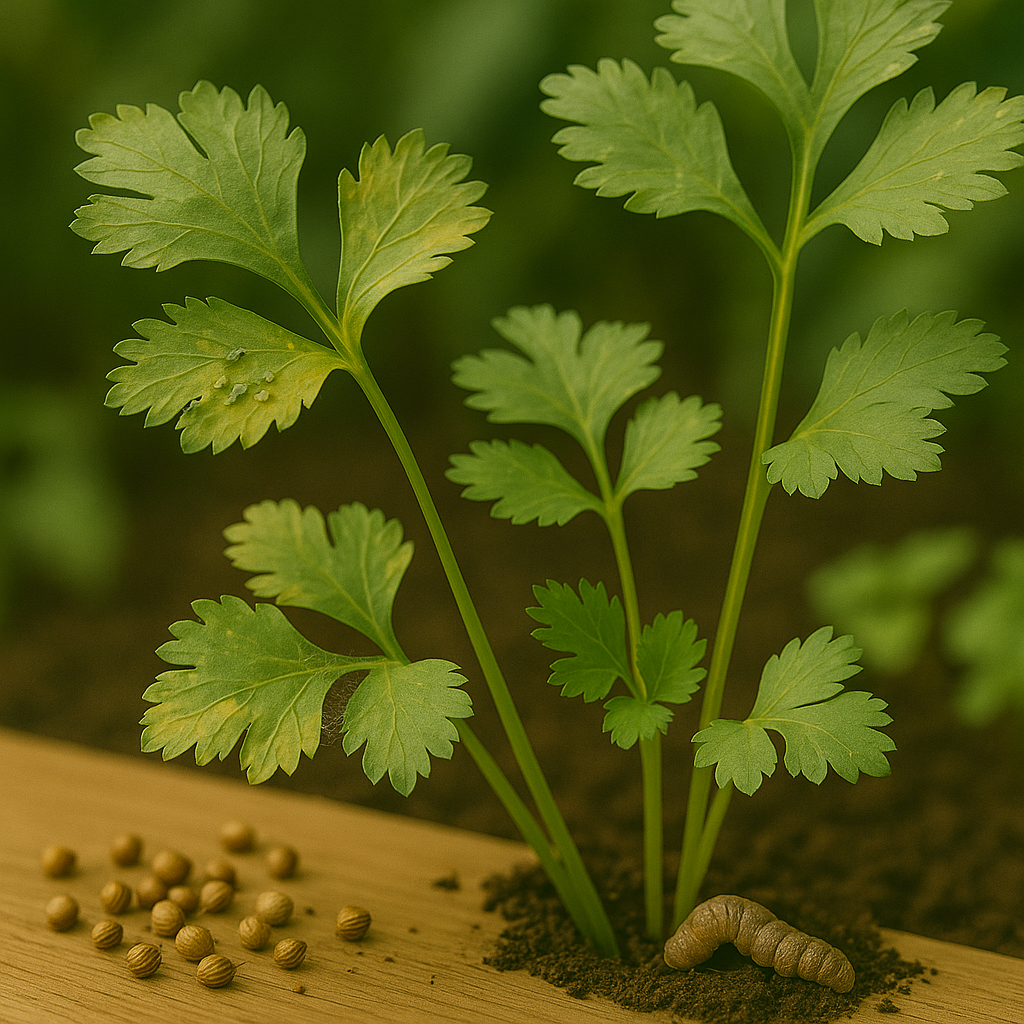
Cilantro is a delicious and popular herb, but it’s unfortunately a magnet for several common garden pests. Aphids, for example, are tiny, soft-bodied insects that cluster on the undersides of cilantro leaves and stems. You might notice their presence through sticky residue (called honeydew), curled leaves, or yellowing foliage.
Spider mites are another frequent offender, especially in warm and dry environments. These minuscule pests leave behind fine, silvery webbing and cause leaves to turn speckled, pale, and eventually drop. Cutworms, which are caterpillar larvae, usually strike at night, chewing through the stems at the base—leading to wilted or toppled young plants.
Recognizing these visible signs—like yellowed, curled, or stunted leaves, mysterious webbing, and cut stems—can help you diagnose what’s causing trouble in your cilantro patch. It’s crucial to accurately identify which pest is responsible before reaching for any treatments since different pests require different solutions.
For instance, aphids might be controlled using a strong spray of water or insecticidal soap, while spider mites often need increased humidity to discourage their spread. Be mindful of environmental factors, too: high humidity, poor air circulation, and overcrowded plants all encourage pests to thrive.
Thinning out dense plantings, watering at the base, and spacing cilantro plants properly can make a big difference. By staying alert to signs of trouble and creating a healthy growing environment, you’ll give your cilantro the best chance to thrive pest-free.
Keeping Cilantro Plants Healthy to Prevent Pests
Maintaining healthy cilantro plants is your first line of defense against pests, and a few simple care practices can make a big difference. Start by watering your cilantro consistently, but avoid overwatering—soggy soil can attract harmful pests and promote disease. Ensure your pots or garden beds have good drainage. Adding a layer of gravel at the bottom of containers helps, or amending garden soil with organic material keeps water moving through.
Space your cilantro plants so air can circulate between them, which reduces humidity that attracts insects like aphids or fungal gnats. The health of your soil is also key; healthy, nutrient-rich soil helps plants grow strong and resilient. Mix in compost before planting to boost beneficial microorganisms and improve soil structure. Compost not only provides slow-release nutrients but also supports a robust root system, making it harder for pests to gain a foothold.
By combining these habits—careful watering, proper drainage, thoughtful spacing, and compost-enriched soil—you’re setting your cilantro up for thriving growth and naturally reducing the risk of pest problems. These steps don’t just keep bugs at bay; they also ensure fuller, tastier herbs for your kitchen.
Natural Pest Control Methods for Cilantro
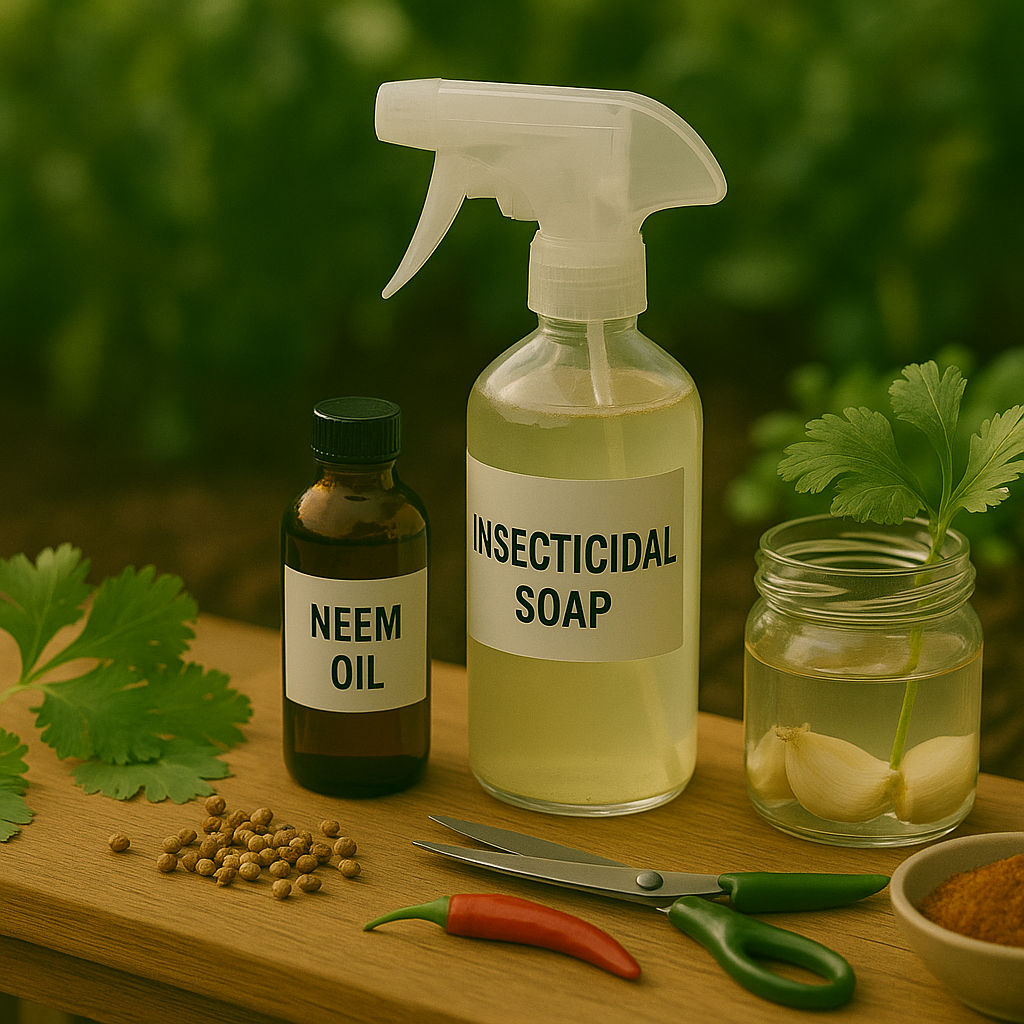
Keeping cilantro pest-free doesn’t require harsh chemicals—natural methods can be just as effective while being gentler on both the plant and the environment.
Neem oil is an excellent organic choice; mix according to label instructions and spray in the early morning or evening to avoid harming beneficial pollinators like bees.
Insecticidal soap is another reliable remedy—either store-bought or homemade using a few drops of mild liquid soap in a quart of water. Spray directly on pests like aphids or whiteflies, but rinse the cilantro leaves after a couple of hours to avoid residue buildup.
For homemade solutions, diluted garlic spray works wonders as both a deterrent and mild pesticide. Simply crush a few garlic cloves, steep them in water overnight, strain, and spray onto cilantro leaves. The strong scent repels a variety of bugs without harming the plant.
Another easy option is chili pepper spray—blend one tablespoon of chili powder or fresh peppers with a quart of water and a couple of drops of soap, then strain and apply as needed.
Always test any spray on a small section of the plant first, and avoid applying during the heat of the day, which can stress the cilantro.
To protect helpful insects, only apply treatments when you see pests, and try to target just the undersides of leaves where bugs hide.
With these safe, simple strategies, you can keep your cilantro healthy and thriving without resorting to synthetic pesticides.
Beneficial Insects and Companion Planting
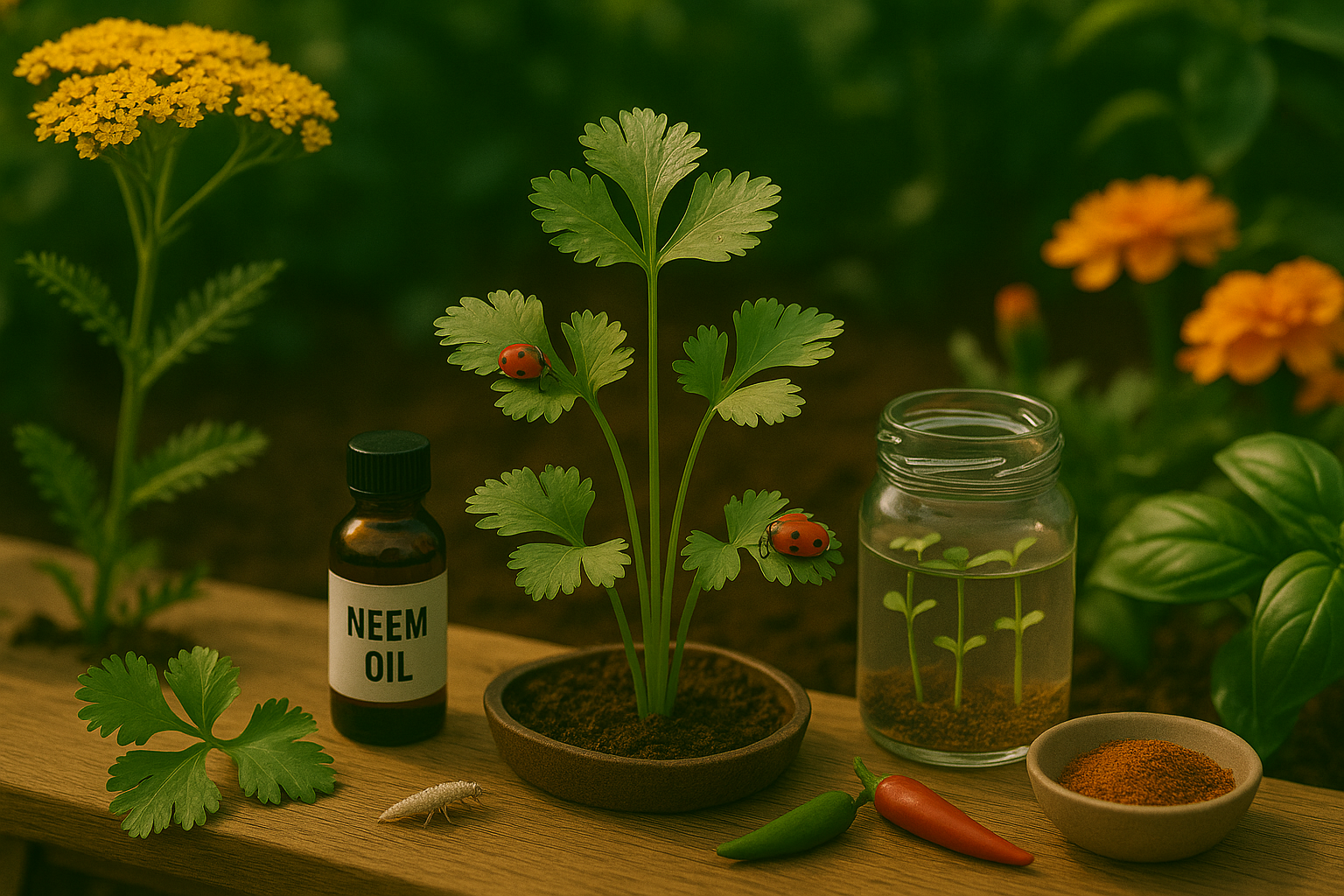
Welcoming beneficial insects into your cilantro garden is one of the smartest ways to keep pests under control without harsh chemicals. Ladybugs and lacewings are garden heroes—their larvae feast on common nuisances like aphids and spider mites.
To attract these insect allies, plant a variety of flowers such as yarrow, cosmos, or calendula nearby, which provide nectar to adults and encourage them to stick around. You can also purchase ladybugs or lacewing eggs from reputable garden centers and release them in the evening, giving them a better chance to settle in.
Companion planting is another natural strategy. Dill and basil work wonders alongside cilantro by confusing or repelling pests like aphids, while the strong scent of marigolds helps deter harmful insects including nematodes and whiteflies.
Intermixing these plants not only boosts your garden’s resilience but also enhances yields and overall pollinator activity. Remember to avoid using broad-spectrum insecticides, as these can harm your helpful insects.
With intentional planning and the right mix of plants, your cilantro patch can thrive naturally with minimal intervention—making both your harvest and the garden ecosystem healthier.
Monitoring and Long-term Prevention
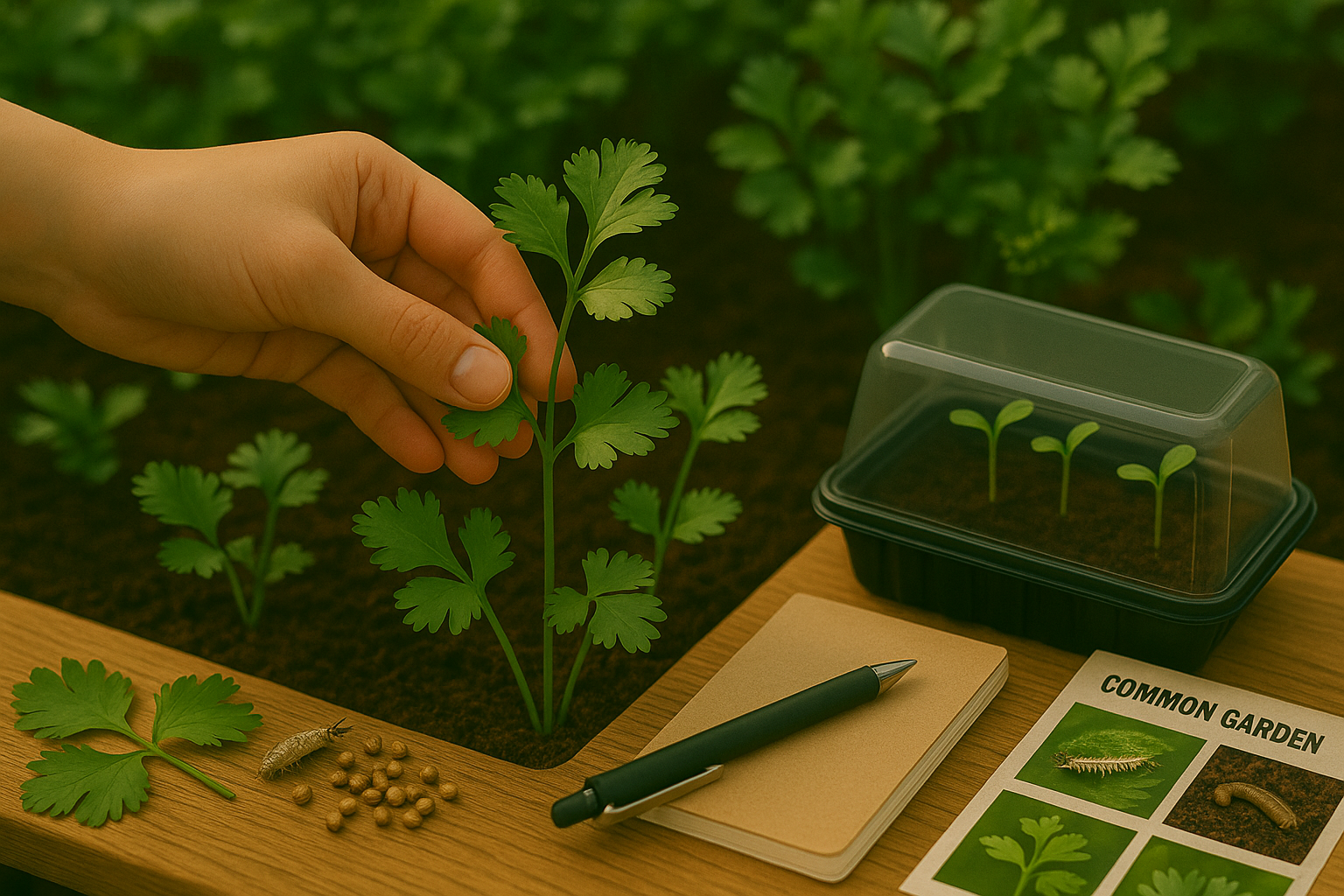
Regular pest scouting is crucial for keeping harmful insects and diseases in check before they cause serious damage. By closely inspecting your plants at least once a week, you can spot early warning signs like chewed leaves, discoloration, or the presence of larvae. Catching these issues early allows for swift, targeted interventions, potentially avoiding the need for harsher chemical treatments.
Practical tactics like crop rotation—changing the location of plant families each year—can break pest life cycles and reduce the risk of recurring infestations. Similarly, proper plant spacing improves airflow, reduces humidity, and makes it harder for pests and diseases to spread quickly across your garden.
Another useful strategy is keeping detailed records of what pests you find, when you find them, and the control methods you use. Over the seasons, these notes become invaluable, allowing you to track which strategies are most effective, spot patterns, and prepare for problems before they start. For example, if aphids always show up in early May, you can plan preventative measures ahead of time.
Together, ongoing scouting, thoughtful crop management, and record keeping create a powerful system for long-term pest prevention and healthier plants.
Conclusion
Embracing a holistic, natural approach to pest management in cilantro not only provides safer herbs for your kitchen but also supports a healthier garden ecosystem overall. By starting with prevention—such as crop rotation, good airflow, and encouraging natural predators—you can minimize pest problems without relying on chemicals.
Simple solutions like neem oil or handpicking pests can keep your cilantro thriving. Remember, every garden is unique, so observing your plants and adapting your methods will lead to the best results.
Have you tried any natural pest control strategies? Share your experiences or questions in the comments below—we’d love to hear from you!
